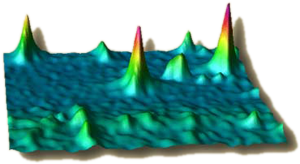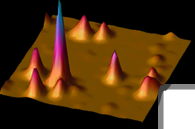Basics
Single-Molecule Probes of Nanoenvironments in Condensed Matter,
Explorations in Solids or Cells Using a Nanometer-Sized Probe, or
Probing Local Environments Using Single-Molecule Spectroscopy and
Microscopy.

Figure 1: Imaging Single Molecules of Pentacene
in a p-Terphenyl Crystal |
Most chemical experiments in condensed matter measure the average
behavior of a huge number, N, of molecules, where N may range from
millions to billions to Avogadro's Number. At the same time, most
theoretical models are intended to describe the behavior of a single
molecule interacting with its surroundings, and averaging over the
number of molecules N is normally required to compute an observable.
Using precision laser spectroscopic techniques, we have been detecting
and probing the detailed properties of individual impurity
molecules hidden deep inside a solid, a protein, or even in a liquid,
i.e., the ultimate limit of N=1. This was first done in the Moerner
Lab in 1989, and has since expanded dramatically to include many
groups around the world. A key reason for doing this is to explore
heterogeneity that is normally obscured by ensemble averaging.
Studying one individual molecule in a solid means we are working
with an extremely small number of moles of material. You might be
aware that the international standards organization, IUPAC, has defined
several new prefixes: zepto- for 1E-21, and yocto- for 1E-24. Thus
1 molecule is equivalent to 1.66 yoctomoles. But we think this is
unwieldy. Thus we define a new prefix guaca- so that (with apologies
to Prof. Avogadro)
1 guacamole = 1 / ( Avocado's Number) of moles.
More seriously, it is worth recalling that each molecule we are
probing is only 1 or 2 nanometers in size. This means that when we
use a laser to select one probe molecule, we can sense details of
the immediate local environment of a truly nanoscopic probe.
To achieve this extreme reduction of the concentration and reach
the single-molecule level, we use either (a) low-temperature high-resolution
laser spectroscopy to select individual molecules by their resonance
frequencies, or (b) near field optical excitation to pump sample
volumes much smaller than the diffraction limit, or (c) extremely
low concentrations and diffraction-limited confocal or far-field
microscopy. By studying a large number of individual molecules one
at a time, we are able not only to observe how the usual ensemble
average behavior is formed, but also to see unexpected, surprising
behavior normally hidden by the usual ensemble averaging.
The phenomena under study in the early work at low temperatures included spontaneous changes in resonant
frequency caused by host matrix dynamics (spectral diffusion) as
well as light-induced resonant frequency changes, akin in principle to optical storage on a single molecule level. Since a very
narrow optical transition is extremely sensitive to perturbations,
extremely small changes in the local environment were probed by the application
of electric, strain, or magnetic fields. By dispersing the emitted
light, even the vibrational mode spectrum of a single molecule was measured! By measuring correlations in the emitted photon stream,
fast dynamics including environmental fluctuations, or the purely
quantum-mechanical behavior termed photon antibunching may be probed.
At room temperature, a huge variety of additional physical and chemical effects can be studied spanning multiple fields from biology to materials science. In biomolecules, we observe fascinating differences in behavior of single molecules due
to conformational states, local environments, or enzymatic cycle,
all of which are obscured in large N experiments. Single labeled biomolecules can be observed even in living cells, where now the behaviors of individual nanomachines can be addressed. Since the single fluorescent dye label acts as a nanometer-sized light source, today single-molecule imaging has provided a pathway to surpass the optical diffraction limit.
Nobel Lecture, Autobiography, and Written Nobel Lecture
Nobel Lecture Page with full details: Video, written article, and slides: "William E. Moerner - Nobel Lecture: Single-Molecule Spectroscopy, Imaging, and Photocontrol: Foundations for Super-Resolution Microscopy". Nobelprize.org. Nobel Media AB 2014. Web. 19 Nov 2015. <http://www.nobelprize.org/nobel_prizes/chemistry/laureates/2014/moerner-lecture.html>
Nobel Lecture Article with a few typo corrections: Angewandte Chemie and Reviews of Modern Physics
Nobel Autobiography (as of January 2015): "William E. Moerner - Biographical". Nobelprize.org. Nobel Media AB 2014. Web. 19 Nov 2015. <http://www.nobelprize.org/nobel_prizes/chemistry/laureates/2014/moerner-bio.html>
Selected Bibliography and Reviews (chronological)
- "Optical Detection and Spectroscopy of Single Molecules
in a Solid," by W. E. Moerner and L. Kador, Phys. Rev. Lett. 62, 2535 (1989). This is the first report of single-molecule detection and spectroscopy in condensed phases.
- "Fluorescence Spectroscropy and Spectral Diffusion of Single
Impurity Molecules in a Crystal," by W.P. Ambrose and W. E.
Moerner, Nature 349, 225 (1991).
- "Spectroscopy of Single Impurity Molecules in Solids," by
W. E. Moerner and Th. Basche', Angew. Chem. 105, 537 (1993); Angew.
Chem. Int. Ed. Engl. 32, 457 (1993).
- "Examining Nanoenvironments in Solids on the Scale of a
Single, Isolated Impurity Molecule," by W. E. Moerner, Science
265, 46 (1994).
- "High-Resolution Optical Spectroscopy of Single Molecules
in Solids, by W. E. Moerner, in "Single Molecules and Atoms," Special
Issue of Accounts of Chemical Research, December 1996.
- "Fundamentals of Single-Molecule Spectroscopy in Solids," Chapter
1 of Single Molecule Optical Detection, Imaging, and Spectroscopy,
T. Basche, W. E. Moerner, M. Orrit, and U. P. Wild, eds. (Verlag
Chemie, Munich, 1997).
- W. E. Moerner, "Those Blinking Single Molecules," Science
277, 1059 (1997).
- W. E. Moerner and M. Orrit, "Illuminating Single Molecules
in Condensed Matter," Science 283, 1670-1676 (1999).
- B. Lounis and W. E. Moerner, "Single Photons on Demand
from a Single Molecule at Room Temperature," Nature 407, 491-493
(2000).
- H. Sosa, E. J. G. Peterman, W. E. Moerner, and L. S. B. Goldstein,
"ADP-Induced Rocking of the Kinesin Motor Domain Revealed
by Single-Molecule Fluorescence Polarization Microscopy," Nature
Structural Biology 8, 540-544 (2001).
- W. E. Moerner, "Thirteen Years of Single-Molecule Spectroscopy in Physical Chemistry and Biophysics," in Single-Molecule Spectroscopy: Nobel Conference Lectures, R. Rigler, M. Orrit, Th. Basche, Editors, Springer Series in Chemical Physics, Volume 67 (Springer-Verlag, Heidelberg, 2001), pp. 32-61.
- W. E. Moerner, "A Dozen Years of Single-Molecule Spectroscopy
in Physics, Chemistry, and Biophysics," J. Phys. Chem. B 106,
910-927 (2002).
- W. E. Moerner, "Single-Molecule Optical Spectroscopy of
Autofluorescent Proteins," J. Chem. Phys. 117, 10925 (2002).
- W. E. Moerner and D. P. Fromm, "Methods of Single-Molecule
Fluorescence Spectroscopy and Microscopy," Rev. Sci. Instrum.
74, 3597-3619 (2003).
- E. J. G. Peterman, H. Sosa, and W. E. Moerner, “Single-Molecule Fluorescence Spectroscopy and Microscopy of Biomolecular Motors,” invited review, Ann. Rev. Phys. Chem. 55, 79-96 (2004).
- P. J. Schuck, D. P. Fromm, A. Sundaramurthy, G. S. Kino, and W. E. Moerner, “Improving the Mismatch Between Light and Nanoscale Objects with Gold Bowtie Nanoantennas,” Phys. Rev. Lett. 94, 017402 (2005).
- K. A. Willets, S. Y. Nishimura, P. J. Schuck, R. J. Twieg, and
W. E. Moerner, "Nonlinear Optical Chromophores as Nanoscale
Emitters for Single-Molecule Spectroscopy," invited review,
Accounts Chem. Res. 38, 549-556 (2005)
- S. Y. Kim, Z. Gitai, A. Kinkhabwala, L. Shapiro, and W. E. Moerner, “Single Molecules of the Bacterial Actin MreB Undergo Directed Treadmilling Motion in Caulobacter crescentus,” Proc. Nat. Acad. Sci. (USA) 103, 10929-10934 (2006).
- A. E. Cohen and W. E. Moerner, “Suppressing Brownian Motion of Individual Biomolecules in Solution,” Proc. Nat. Acad. Sci. (USA) 103, 4362-4365 (2006).
- W. E. Moerner, “New Directions in Single-Molecule Imaging and Analysis,” Invited Perspective, Proc. Nat. Acad. Sci. (USA) 104, 12596-12602 (2007).
- J. S. Biteen, M. A. Thompson, N. K. Tselentis, G. R.Bowman, L. Shapiro, W. E. Moerner, “Superresolution Imaging in Live Caulobacter Crescentus Cells Using Photoswitchable EYFP,” Nature Meth. 5, 947-949 (2008).
- W. E. Moerner, “Single-Molecule Optical Spectroscopy and Imaging: From Early Steps to Recent Advances,” in Single Molecule Spectroscopy in Chemistry, Physics and Biology: Nobel Symposium 138, Springer Series in Chemical Physics Vol. 96, A. Gräslund, R. Rigler, J. Widengren, Eds. ( Springer-Verlag, Berlin, 2009), pp. 25-60.
- A. Kinkhabwala, Z. Yu, S. Fan, Y. Avlasevich, K. Müllen, and W. E. Moerner, “Large Single-Molecule Fluorescence Enhancements Produced by a Bowtie Nanoantenna,” Nature Photonics 3, 654-657 (2009).
- S. J. Lord, H.-L. D. Lee, and W. E. Moerner, “Single-Molecule Spectroscopy and Imaging of Biomolecules in Living Cells," Anal. Chem. 82, 2192-2203 (2010) .
- M. A. Thompson, J. S. Biteen, S. J. Lord, N. R. Conley, and W. E. Moerner, “Molecules and Methods for Super-Resolution Imaging,” in Methods in Enzymology, Volume 475, Nils G. Walter, Editor (Elsevier, New York, 2010), Chapter 2, pp. 27-59. DOI
- Michael A. Thompson, Matthew D. Lew, and W. E. Moerner, “Extending Microscopic Resolution with Single-Molecule Imaging and Active Control,” Annual Reviews of Biophysics 41, 321-342 (2012). DOI
- Matthew D. Lew, Steven F. Lee, Michael A. Thompson, Hsiao-lu D. Lee, and W. E. Moerner, “Single-Molecule Photocontrol and Nanoscopy,” in Far-Field Optical Nanoscopy, P. Tinnefeld, C. Eggeling, and S. W. Hell, Eds., Springer Series on Fluorescence (Springer, Berlin, Heidelberg, 2012). DOI
- Quan Wang, Randall H. Goldsmith, Yan Jiang, Samuel D. Bockenhauer, and W.E. Moerner, “Probing single biomolecules in solution using the Anti-Brownian ELectrokinetic (ABEL) trap,” Acc. Chem. Res. 45, 1955-1964 (Paul Barbara Special Issue) (2012). DOI
- W. E. Moerner, “Microscopy beyond the diffraction limit using actively controlled single molecules,” J. Microsc. 246, 213-220 (2012). DOI
- Steffen J. Sahl and W. E. Moerner, "Super-resolution Fluorescence Imaging with Single Molecules,” Curr. Opin. Struct. Biol. 23, 778-787 (2013). DOI
- Andreas Gahlmann and W. E. Moerner, “Exploring bacterial cell biology with single-molecule tracking and super-resolution imaging,” Nature Reviews Microbiology 12, 9-22 (2014), published online December 16, 2013. DOI
- Mikael P. Backlund, Matthew D. Lew, Adam S. Backer, Steffen J. Sahl, and W. E. Moerner, “The role of molecular dipole orientation in single-molecule fluorescence microscopy and implications for super-resolution imaging,” Minireview, ChemPhysChem 15, 587-599 (2014), published online December 30, 2013. DOI
- W. E. Moerner, Yoav Shechtman, and Quan Wang, “Single-molecule spectroscopy and imaging over the decades,” Faraday Discuss. xx, 1-28 (2015) (DOI:10.1039/c5fd00149h, published online November 30, 2015). DOI
- Alex von Diezmann, Yoav Shechtman, and W. E. Moerner, “Three-Dimensional Localization of Single Molecules for Super-Resolution Imaging and Single-Particle Tracking,” Chem. Revs. Special Issue on Super-Resolution and Single-Molecule Imaging (in press, DOI: 10.1021/acs.chemrev.6b00629, published online 2 February 2017). DOI
- Leonhard Möckl and W. E. Moerner, “Super-resolution microscopy with single molecules in biology and beyond – essentials, current trends, and future challenges,” Perspective Article, J. Am. Chem. Soc. 142, 17828-17844 (2020) (DOI: 10.1021/JACS.0c08178, published online 9 October 2020).
|



